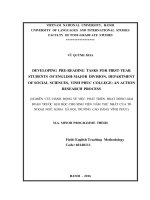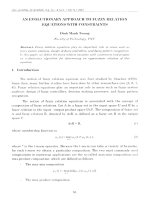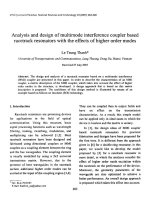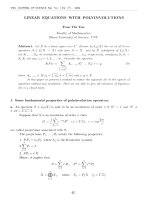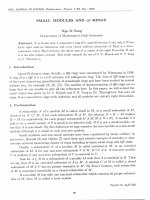DSpace at VNU: Small Box-Behnken designs with orthogonal blocks
Bạn đang xem bản rút gọn của tài liệu. Xem và tải ngay bản đầy đủ của tài liệu tại đây (360.52 KB, 7 trang )
Statistics and Probability Letters 85 (2014) 84–90
Contents lists available at ScienceDirect
Statistics and Probability Letters
journal homepage: www.elsevier.com/locate/stapro
Small Box–Behnken designs with orthogonal blocks
Tung-Dinh Pham a,∗ , Nam-Ky Nguyen b
a
VNU University of Science, Hanoi, Viet Nam
b
International School, Vietnam National University, Hanoi, Viet Nam
article
abstract
info
Article history:
Received 29 June 2013
Received in revised form 16 October 2013
Accepted 17 October 2013
Available online 23 November 2013
A new method of constructing 3-level second-order designs using incomplete block designs
with unequal block sizes is suggested to any number of factors. The method gives orthogonally blocked designs with small run sizes, high D-efficiencies and rotatability measures.
© 2013 Elsevier B.V. All rights reserved.
Keywords:
Balanced incomplete block designs
D-optimality
Response surface designs
Rotatability measure Q ∗
Second-order designs
1. Introduction
Box and Behnken (1958, 1960) introduced the 3-level second-order designs (SODs) for fitting the second-order response
surface model
y = β0 +
k
i =1
βi xi +
k
i =1
βii x2i +
k−1
k
βij xi xj + ϵ,
(1)
i=1 j=i+1
for m factors x1 , . . . , xm in n runs, where y is the response vector, βi ’s are main effects, βii ’s are quadratic effects, βij ’s are
interaction effects with i, j = 1, . . . , m and ϵ is a vector of white noise. These designs, abbreviated as BBDs were constructed
from either a balanced incomplete block design (BIBD) or a partially BIBD (PBIBD) and a 2-level factorial (or a half fraction
of a 2-level factorial as in the case of BBD for 11 factors) which is used to superimpose onto treatments in each block of the
BIBD or PBIBD. BBDs are very popular among experimenters for the following reasons:
(i) BBDs are 3-level designs, i.e. BBDs require a minimum number of levels for each factor;
(ii) each factor of a BBD has the same number of runs at high level and at low level;
(iii) BBDs are either rotatable (for BBDs with 4 and 7 factors) or near-rotatable. Box and Hunter (1957)
an mcalled
m
2
dimensional design rotatable if the prediction variance at the point (x1 , . . . , xm ) is a function of ρ 2 =
i=1 xi , i.e. the
prediction variances are equal for all points equidistant from the center of the design region. This is a desirable property
for any experimental design.
(iv) with the exception of the BBD for three and 11 factors, all BBDs can be orthogonally blocked. For an orthogonally blocked
SOD, the inclusion of blocks does not affect the estimated regression coefficients for model (1).
(v) the X ′ X (and (X ′ X )−1 ) matrices of BBDs have a very simple structure and this leads to simplicity of calculation and the
interpretation of results.
∗
Corresponding author.
E-mail addresses: (T.-D. Pham), (N.-K. Nguyen).
0167-7152/$ – see front matter © 2013 Elsevier B.V. All rights reserved.
/>
T.-D. Pham, N.-K. Nguyen / Statistics and Probability Letters 85 (2014) 84–90
85
Let the u-th row of the Xn×p , the expanded design matrix of a SOD for m factors in n runs be written as 1, x21 , . . . , x2m ,
x1 , . . . , xm , x1 x2 , . . . , xm−1 xm , where p = (m + 1)(m + 2)/2 is the number of parameters in (1). While, the X ′ X matrices of
the SODs such as the augmented-pair designs (Morris, 2000) and the small central composite designs or small CCDs (Nguyen
and Lin, 2011) will have the form
0
B
A
0
,
(2)
where A is a square matrix of order m + 1 and B is a square matrix of order m + (m
2 ) (=
the BBD for 11 factors) and the CCDs of Box and Wilson (1951) will have the form
0
D
A
0
(m + 1)), the ones of BBDs (except
1
m
2
(3)
where D is a diagonal matrix. Clearly, the m main and (m
2 ) interaction effects in (1) can only be estimated orthogonally if the
X ′ X matrices are of the form (3).
In recent years, there has been a strong interest in constructing IBD-based SODs. Nguyen and Borkowski (2008) improved
seven PBIBD-based BBDs in terms of rotatability and D-efficiency. In addition, they report new orthogonally blocked designs
for 5, 8, 9, 11 and 13 factors. Dey (2009) constructed highly D-efficient orthogonally blocked 3-level SODs by using BIBDs of
block size two and the 22 factorial. While the X ′ X matrices of BBDs and designs of Nguyen and Borkowski (2008) and Dey
(2009) have the form (3), their run sizes are unnecessarily large particularly when the number of factors increases.
Zang et al. (2011) constructed small 3-level SODs which they call small BBDs (SBBDs) by using BIBDs and PBIBDs and
2-level factorials and a 23III−1 fractional factorial. These SBBDs cannot be orthogonally blocked. Recently, Dey and Kole (2013)
3−1
(hereafter abbreviated as DK) proposed small orthogonally blocked 3-level SODs by using IBDs of block size three and a 2III
and its fold-over. These designs have reasonably high D-efficiencies. While the designs of Zang et al. (2011) and DK have
substantially small run sizes, their X ′ X matrices have the form (2).
In this paper, we present new 3-level SODs based on IBDs with unequal block sizes. We call these designs SBBDs in the
sense they have the smaller number of runs than the original BBDs and at the same time retain all desirable features of the
original BBDs.
2. IBDs with unequal block sizes
IBDs with equal block sizes and their use to construct 3-level SODs have been discussed in the work of the authors
mentioned in Section 1. The next paragraphs give a summary of IBDs in general.
An IBD of size (v, b, r ) is an arrangement of v treatments set out in b blocks of different sizes such that each treatment
occurs in r blocks and no treatment occurs more than once in any block. The blocks can be of the same size or of different sizes.
When the blocks can be divided into subsets, each of which is a replicate of the treatments, the IBD is said to be resolvable.
An IBD is associated with its (treatment) concurrence matrix NN ′ = {λij } with λii = r , (i = 1, . . . , v) and λij (i ̸= j) is
the number of blocks in which both treatments i and j appear. BIBDs are IBDs with a constant block size k and a constant λ.
In this paper, the SBBDs are constructed by IBDs with two treatment concurrences λij = 1 and 2. These IBDs are obtained
by either adding one or two new treatments to a BIBD or removing a treatment from a BIBD. The next two paragraphs give
examples on this method of construction.
Consider the following is a 2 × 2 balanced lattice, a resolvable BIBD of size (v, b, r ) = (4, 6, 3), i.e. (0 1), (2 3); (0 2),
(1 3); (0 3), (2 1). Its NN ′ matrix is 2I4×4 + J4×4 where I is the identity matrix and J is a matrix of 1’s. Adding the 5th treatment
to the last two blocks of this balanced lattice and doubling all blocks of size 3 will result in the IBD of size (v, b, r ) = (5, 8, 4):
(0 1), (2 3), (0 2), (1 3), (0 3 4), (0 3 4), (2 1 4) and (2 1 4). The NN ′ matrix of this IBD is
4
1
1
2
2
1
4
2
1
2
1
2
4
1
2
2
1
1
4
2
2
2
2 .
2
4
Now consider the following is a cyclic BIBD (a BIBD generated by an initial block) of size (v, b, r ) = (7, 7, 3): (0 2 3),
(1 3 4), (2 4 5), (3 5 6), (4 6 0), (5 0 1) and (6 1 2). Its NN ′ matrix is 2I7×7 + J7×7 . Removing the 7th treatment from this cyclic
BIBD and doubling all blocks of size 3 will result in the IBD of size (v, b, r ) = (6, 11, 5): (0 2 3), (0 2 3), (1 3 4), (1 3 4),
(2 4 5), (2 4 5), (3 5), (4 0), (5 0 1), (5 0 1) and (12). The NN ′ matrix of this IBD is
5
2
2
2
1
2
2
5
1
2
2
2
2
1
5
2
2
2
2
2
2
5
2
1
1
2
2
2
5
2
2
2
2
.
1
2
5
86
T.-D. Pham, N.-K. Nguyen / Statistics and Probability Letters 85 (2014) 84–90
3. Method of constructing SBBDs
BBDs are formed by superimposing 2-level factorials onto treatments in each block of a BIBD or PBIBD. The exception
is the 11-factor BBD where a half fraction of a 24 factorial is used. The following is the matrix representing a 4-factor BBD
(without center points) formed by superimposing a 22 factorial onto treatments in each block of a 2 × 2 balanced lattice
mentioned in Section 2:
±1
±1
0
±1
0
±1
0
0
±1
0
±1
0
0
±1
±1
0
0
±1
0
±1
0
.
±1
±1
0
Here (±1 ± 1) represents a 22 factorial and 0 represents a column vector of four 0’s. It can be verified that the core of the
matrix A (matrix A with its first row and column removed) in (3) of this 4-factor BBD is four times the NN ′ matrix of the
associated BIBD.
Now, superimposing a 22 factorial onto treatments in each block of size two and a 23 factorial onto treatments in each
pair block of size three of the IBD of size (v, b, r ) = (5, 8, 4) in Section 2, we have the following matrix representing a
5-factor SBBD (without center points):
±1
±1
0
±1
0
±1
0
0
±1
0
±1
0
0
±1
±1
0
0
±1
0
±1
0
±1
±1
0
0
0
0
.
0
±1
±1
Here (±1 ± 1) represents a 22 factorial, (±1 ± 1 ± 1) represents a 23 factorial, and 0 represents a column vector either
four 0’s or eight 0’s depending on whether it lies in rows with (±1 ± 1) or (±1 ± 1 ± 1). Again, it can be verified that the
core of the matrix A in (3) of this 5-factor SBBD is four times the NN ′ matrix of the associated IBD.
The matrix representing the 7-factor BBD displayed in the Appendix can be constructed from the cyclic BIBD of size
(v, b, r ) = (7, 7, 3) in Section 2. The matrix representing the 6-factor SBBD can be constructed from the IBD of size (v, b, r )
= (6, 11, 5) in Section 2. This matrix can also be obtained by deleting the last column of the matrix representing the 7-factor
BBD. Similarly, the matrices representing the SBBDs for m = 8, 12 and 15 factors can be obtained by deleting the last column
of the matrices representing the BBD for m + 1 factors.
The IBDs associated with matrices representing the SBBDs for 10 and 11 factors are obtained by adding one and two
treatments to the 3 × 3 simple lattice, a BIBD of size (v, b, r ) = (9, 12, 4). We failed to construct the IBD associated with
the matrix representing the efficient SBBDs for 14 factors.
4. New small BBDs with orthogonal blocks
The matrices representing the IBD-based designs for 4–6 factors are in Section 3 and the ones for 8–13 and 15–16 factors
are in the Appendix. Note that the matrices for m = 6, 8, and 15 factors can be obtained by deleting the ones for m + 1 factors.
With the exception of the design for 11 factors, all designs have the BBD properties with the X ′ X matrices having the form
(3). The design for 11 factors contains two fractions of the 24 factorial. Table 1 gives for each design, the number of factors
m, the number of parameters p, the IBD of size (v, b, r ) parameters used to construct the corresponding IBD-based SOD, the
number of runs n and center points n0 , and the D-efficiency (see Dey, 2009 or DK for the computation of this D-efficiency).
The BIBD-based designs in Table 1 are not new: the ones for 4 and 7 factors were reported in Box and Behnken (1960)
and the ones for 9, 13 and 16 factors were reported independently in Crosier (1991) and Nguyen and Borkowski (2008). We
call the seven new designs in Table 1, i.e. the ones for m = 5, 6, 8, 10, 11, 12 and 15 SBBDs. The D-efficiencies of our SBBDs
are in the range 70%–90% which are on par with the ones of DK. The rotatability measure Q ∗ (see Draper and Pukelsheim,
1990 for the computation of this measure) of our SBBDs are all greater than 0.99. Section 5 gives details of the orthogonal
blocking of these designs.
Table 2 displays the runs sizes and the number of orthogonal blocks of BBDs, DK design and our SBBDs with up to 12
factors. For each m, only the DK design with the smallest run size is listed. It can be seen that for m = 5 and 6, our SBBDs
have the smallest run sizes. For m = 8–11, the runs sizes of DK designs have the smallest run sizes, however. Experimenters
looking for orthogonally blocked 3-level SODs for 8–11 factors with limited resources should consider DK designs seriously
despite the fact that the X ′ X matrices of these designs have the form (2) instead of (3).
Some DK designs have low D-efficiencies due the fact that the generating IBDs are not efficient ones. For the DK design
for 10 factors, for example, if we replace the generating IBD for 10 factors in Table 1 of DK by a cyclic IBD for (v, b, r ) =
(10, 20, 6) generated by two initial blocks (0, 1, 5) and (0, 1, 8), we will be able to improve the D-efficiency of this design
from 67.35 to 72.27%.
T.-D. Pham, N.-K. Nguyen / Statistics and Probability Letters 85 (2014) 84–90
87
5. Orthogonal blocking of IBD-based SODs
Below are the situations where orthogonal blocking is possible for IBD-based SODs:
(i) where replicate sets are found in the generating IBD. An example is the design for m = 4 in Table 1 where each replicate
forms a block.
(ii) where the component 23 and 24 factorials can be divided into two orthogonal blocks by confounding the highest order
interaction. Examples are designs for m = 7 and 13 in Table 1.
(iii) where both (i) and (ii) apply. The designs for m = 9 and 16 in Table 1 fall into this category. The design for nine factors
has four replicates and each replicate can be divided into two orthogonal blocks. Thus this design can be divided into
eight orthogonal blocks.
(iv) where neither (i) nor (ii) applies. Designs for m = 5, 6, 8, 10, 11, 12 and 15 fall into this category. These designs can be
blocked into two orthogonal blocks by the CUT algorithm of Nguyen (2001) which is implemented in the CUT program
of the Gendex DOE toolkit ( />Designs for m = 4 to 7 can be orthogonally blocked by two blocking factors (e.g. rows and columns or days and batches,
etc.) by the use of the mentioned CUT program. The following is the orthogonal partition of the 5-factor SBBD (arranged
vertically) in 36 runs which includes four center runs in two rows and two columns:
−1
−1
0
0
−1
0
0
0
1
0
0
−1
−1
−1
−1
0
0
0
0
0
−1
1
1
0
0
0
−1
−1
−1
−1
0
1
0
1
0
−1
0
0
0
0
0
0
1
0
−1
0
0
1
−1
0
0
0
1
1
0
0
0
0
0
0
0
1
−1
0
−1
1
0
0
−1
−1
1
0
0
1
1
−1
−1
−1
0
−1
0
0
0
0
0
1
−1
0
1
0
1
0
1
0
0
−1
1
1
1
0
0
0
−1
−1
0
0
0
−1
−1
0
0
1
1
−1
0
−1
0
1
0
1
0
0
0
0
0
0
0
−1
−1
0
0
1
−1
0
1
0
0
−1
1
0
0
1
0
−1
0
0
0
0
0
0
0
1
1
0
1
0
1
1
0
−1
1
−1
0
0
0
1
0
−1
0
0
1
0
0
1
−1
1
0
1
0
0
This design has been recommended for a pie crust experiment with five 3-level factors to be conducted in two different
ovens at two different times of the day. This is a typical 3-level SOD with two blocking factors used in the food industry
(cf. Gilmour and Trinica, 2003).
6. Concluding remarks
This paper reports the construction of 12 IBD-based 3-level SODs. We call seven new designs, i.e. the ones for m = 5, 6, 8,
10, 11, 12 and 15 constructed from the IBDs with unequal block sizes small BBDs or SBBDs. These SBBDs have not been
reported elsewhere. The IBD-based design for 15 factors has neither appeared in Box and Behnken (1958, 1960) nor Nguyen
and Borkowski (2008). The remaining six designs have substantially smaller number of runs than the ones reported by
these authors, high rotatability measures and at the same time without much sacrifice in the D-efficiencies. All designs can
be orthogonally blocked. Those with m ≤ 7 can be orthogonally blocked by two blocking factors. These designs, given at
complement the designs of DK and give experimenters more flexibility in the
choice of small orthogonally blocked 3-level SODs.
Acknowledgments
The authors would like to thank two referees for many helpful comments and suggestions which helped us to improve
the quality of the paper.
Appendix. Matrices representing SBBDs for m = 6, . . . , 16
m=7
±1
0
0
0
±1
±1
0
±1
0
±1
±1
0
±1
0
0
0
±1
0
0
0
0
±1
0
±1
±1
0
0
0
±1
±1
0
0
0
0
±1
0
±1
±1
0
0
±1
±1
0
0
±1
±1
0
0
±1
88
T.-D. Pham, N.-K. Nguyen / Statistics and Probability Letters 85 (2014) 84–90
Table 1
D-efficiencies of new SBBDs.
m
4a, b
5b
6b
7a, b
8
9a
10
11
12
13a
15
16a
a
b
m=9
±1
0
0
±1
0
0
±1
0
0
±1
0
0
0
±1
0
±1
0
0
0
0
±1
0
±1
0
0
0
±1
±1
0
0
0
±1
0
0
0
±1
±1
m = 10
±1
0
0 ±1
0
0
±1 ±1
0
0
0
0
±1
0
0
0
0 ±1
±1
0
±1
0
0 ±1
0
0
0
0
±1
±1
0
0
0
±1
0
0
0
0
±1
m = 11
±1
0
0 ±1
0
0
±1 ±1
0
0
0
0
±1
0
±1
0
0
0
0 ±1
±1
0
±1
0
0 ±1
0
0
0
0
0
0
±1
±1
0
0
0
0
±1
0
0
0
0
±1
0
p
(v, b, r )
n + n0
15
21
28
36
45
55
66
78
96
105
136
153
(4, 6, 3)
(5, 8, 4)
(6, 11, 5)
(7, 7, 3)
(8, 20, 7)
(9, 12, 4)
(10, 15, 5)
(11, 19, 6)
(12, 22, 7)
(13, 13, 4)
(15, 35, 9)
(16, 20, 5)
24 + 3
32 + 2
44 + 2
56 + 2
80 + 2
96 + 8
120 + 2
152 + 2
176 + 2
208 + 2
280 + 2
320 + 10
Already reported by other authors.
Can be orthogonally blocked by two blocking factors.
0
±1
0
0
±1
0
±1
0
0
0
0
±1
0
0
±1
0
±1
0
0
0
±1
±1
0
0
±1
±1
0
0
±1
0
0
0
0
±1
0
0
±1
0
0
0
±1
±1
0
0
±1
0
±1
0
0
0
0
0
±1
0
0
±1
0
±1
0
0
0
±1
±1
±1
0
0
±1
0
0
0
±1
0
0
±1
0
0
0
±1
0
±1
0
±1
0
0
±1
0
±1
±1
0
0
0
0
0
±1
0
0
0
±1
0
±1
0
0
0
0
±1
±1
±1
0
0
0
±1
0
0
0
±1
0
0
±1
0
0
±1
0
0
0
0
±1
0
0
0
±1
0
0
0
±1
0
0
D-eff
98.86
72.44
85.50
99.93
88.77
95.60
69.21
74.90
90.06
99.11
90.52
96.17
0
0
0
0
±1
0
0
±1
0
0
±1
0
0
0
0
±1
0
0
0
±1
0
0
0
±1
0
0
±1
0
0
0
±1
0
±1
0
±1
0
0
0
0
±1
0
0
±1
±1
0
0
0
±1
0
0
0
0
±1
0
±1
0
±1
±1
0
0
0
0
±1
0
0
±1
±1
0
0
0
0
±1
0
0
0
0
0
0
0
0
0
0
0
±1Ď
±1
±1
0
±1
0
0
0
±1
0
0
±1
0
±1
±1
0
0
0
0
0
±1
0
0
±1
±1
±1
0
0
0
0
±1
0
0
0
0
0
0
0
0
0
±1
±1
±1
0
0
0
0
±1
0
0
0
0
0
0
0
0Ď
0
0
0
±1Ď
±1
±1
±1Ě
T.-D. Pham, N.-K. Nguyen / Statistics and Probability Letters 85 (2014) 84–90
89
Table 2
Run sizes of some orthogonally blocked designsa .
m
BBDs
DK
SBBDs
5
6
7
8
9
10
11
12
42 (2)
50 (2)
58 (2)
–
100 (4)
162 (2)
–
194 (2)
42 (2)
51 (3)
–
65 (5)
65 (5)
82 (2)
90 (2)
–
34 (2)
46 (2)
–
82 (2)
–
122 (2)
154 (2)
178 (2)
a
Number of orthogonal blocks in brackets
(each block contains a center point).
m = 13
±1
0
±1 ±1
0 ±1
0
0
0
0
0
0
0
0
0
0
±1
0
0 ±1
±1
0
0 ±1
0
0
m = 16
±1 ±1
0
0
0
0
0
0
0
±1
0 ±1
0
0
0
0
±1
0
0 ±1
0
0
0
0
±1
0
0 ±1
0
0
0
0
±1
0
0 ±1
0
0
0
0
0
0
±1
±1
0
0
0
0
0
0
±1
0
±1
±1
0
±1
0
0
0
±1
±1
0
0
0
0
0
0
±1
0
±1
0
±1
0
0
±1
±1
0
0
0
0
0
0
±1
±1
±1
0
0
0
0
0
0
0
±1
0
0
0
±1
0
0
0
±1
0
0
0
±1
0
0
0
0
0
0
0
±1
0
0
0
±1
0
0
0
±1
0
0
0
±1
±1
±1
0
0
±1
0
0
0
0
±1
0
0
0
0
±1
0
0
0
0
±1
0
0
0
±1
0
0
±1
0
0
0
0
0
0
±1
0
0
±1
0
0
0
0
0
±1
0
0
0
0
±1
±1
0
0
0
0
±1
0
0
0
0
0
0
0
±1
0
0
±1
0
0
±1
0
0
±1
0
0
0
0
0
±1
±1
0
0
0
0
0
0
±1
±1
0
0
±1
0
±1
0
0
±1
±1
0
0
0
0
0
0
0
±1
0
±1
0
0
±1
±1
0
0
0
0
0
0
0
±1
0
±1
0
0
±1
±1
0
0
0
0
0
0
0
±1
0
±1
0
0
±1
±1
0
0
0
0
0
0
0
±1
0
±1
0
0
±1
±1
0
0
0
0
0
0
±1
0
±1
0
0
±1
0
0
±1
±1
0
0
±1
0
±1
0
0
0
0
0
±1
0
0
0
0
±1
0
±1
0
0
0
0
±1
0
0
±1
0
0
0
0
0
±1
0
0
±1
0
±1
0
0
0
0
0
±1
0
0
0
±1
0
±1
0
0
0
0
±1
0
0
0
0
0
±1
0
0
±1
0
0
0
0
±1
0
±1
0
0
±1
0
0
0
0
0
±1
0
0
0
0
±1
±1
0
0
0
0
0
0
±1
0
±1
0
0
0
0
±1
0
0
±1
0
0
±1
±1
0
0
0
0
0
0
0
0
±1
0
±1
0
0
0
0
±1
0
±1
0
0
0
0
0
0
±1
0
0
0
±1
0
0
±1
0
0
±1
0
0
0
0
0
±1
±1
0
0
0
0
0
0
±1
0
0
0
±1
±1
0
0
0
0
0
±1
0
0
±1
0
0
Notes: The matrices for SBBDs with m = 6, 8, 12 and 15 are obtained by deleting the last column of the matrices for m + 1.
Rows marked with Ď use a half fraction of a 24 factorial. Rows marked with Ě should to be doubled.
References
Box, G.E.P., Behnken, D.W., 1958. Some new three level second-order designs for surface fitting. In: Statistical Technical Research Group Technical Report
No. 26. Princeton University.
Box, G.E.P., Behnken, D.W., 1960. Some new three level designs for the study of quantitative variables. Technometrics 2, 455–475.
Box, G.E.P., Hunter, J.S., 1957. Multifactor experimental designs for exploring response surfaces. Ann. Math. Stat. 28, 195–241.
Box, G.E.P., Wilson, K.B., 1951. On the experimental attainment of optimum conditions. J. R. Stat. Soc. Ser. B Stat. Methodol. 13, 1–45.
Crosier, R.B., 1991. Some New Three-level Response Surface Designs. Technical report CRDEC-TR-308. U.S. Army Chemical Research, Development &
Engineering Center.
Dey, A., 2009. Orthogonally blocked three-level second order designs. J. Statist. Plann. Inference 139, 398–3705.
Dey, A., Kole, B., 2013. Small three-level second-order designs with orthogonal blocks. J. Stat. Theory Pract. 7, 745–752.
90
T.-D. Pham, N.-K. Nguyen / Statistics and Probability Letters 85 (2014) 84–90
Draper, N.R., Pukelsheim, F., 1990. Another look at rotatability. Technometrics 32, 195–202.
Gilmour, S.G., Trinica, L.A., 2003. Row-column response surface designs. J. Qual. Technol. 2, 184–193.
Morris, M.D., 2000. A class of three-level experimental designs for response surface. Technometrics 42, 111–121.
Nguyen, N.-K., 2001. Cutting experimental designs into blocks. Aust. N. Z. J. Stat. 43, 367–374.
Nguyen, N.-K., Borkowski, J.J., 2008. New 3-level response surface designs constructed from incomplete block designs. J. Statist. Plann. Inference 138,
294–305.
Nguyen, N.-K., Lin, D.K.J., 2011. A note on small composite designs for sequential experimentation. J. Stat. Theory Pract. 5, 109–117.
Zang, T.F, Yang, J.F., Lin, D.K.J., 2011. Small Box–Behnken design. Statist. Probab. Lett. 81, 1027–1033.
